The pen is indeed mightier than the sword as proven by these Filipino books that have shaped the course of our history
The page remembers, and it has plenty to tell. As confusing as history can be, we can be sure that our writers and storytellers have captured it for us to remember. For National Heritage Month, we spotlight these five important books that have not only shaped our history, but have also inspired and paved the way for both writers and readers.
Read more: Tracing the Origins of our Filipino Surnames
1. Doctrina Christiana

Acknowledged to be the first book printed in the Philippines, the Doctrina Christiana is one that showcases the history and culture of a time often forgotten. Printed in 1593, the Doctrina Christiana was published using Chinese woodblocks in Manila. It contains multiple Christian prayers: the Lord's Prayer and the Hail Mary to name a few, all written in Spanish, in Tagalog (Roman letters), and even in Baybayin. It reveals not just the fascinating historical languages of these islands, but also shows us a glimpse of the communication styles and barriers, as well as the attitudes of the Spanish friars who created the book. Incredibly priceless, it is kept in the United States Library of Congress but has since been digitalised.




